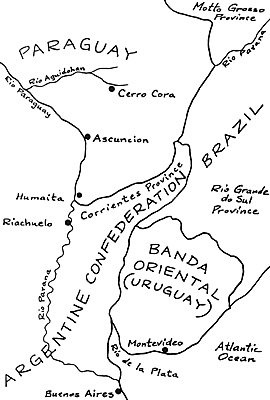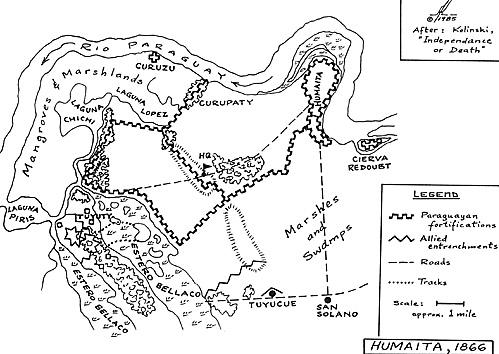 The Paraguayan War (or the War of the Triple Alliance) was the largest and most destructive war ever fought in Latin America; it ranks next to the American Civil War in terms of casualties in the Western Hemisphere. Yet it is largely unknown outside Latin America, except perhapsasa recurring item in historical trivia quizzes. ("What percentage of the male population between 16 and 60 died in the Paraguayan War?" Answer: 90%.)
The Paraguayan War (or the War of the Triple Alliance) was the largest and most destructive war ever fought in Latin America; it ranks next to the American Civil War in terms of casualties in the Western Hemisphere. Yet it is largely unknown outside Latin America, except perhapsasa recurring item in historical trivia quizzes. ("What percentage of the male population between 16 and 60 died in the Paraguayan War?" Answer: 90%.)
It is beyond the scope of this article to delve deeply into the causes or history of this war, but a few words of background are necessary.
Blame for the Paraguayan War is usually laid squarely on the megalomania of Paraguay's President Francisco Solano Lopez. Lopez had been appointed commander of the army at the age of 18 by his father, President Carlos Antonio Lopez. He had his first (very minor) taste of active campaigning in the campaign that overthrew Argentine dictator Rosas. He was then sent on a tour of Europe, where he studied French and British military and manufacturing methods. He came away from this trip with a deeper infatuation with military matters and a desire to make Paraguay the preeminent state of the Rio de la Plata area.
He became president in 1862 on his father's death and began to set his plans in motion. He brought in foreign technicians (especially British) to set up foundries, telegraphs, and railroads. He encouraged other industries and even placed orders for modern river craft. Most ominous to his neighbors, he vastly increased the size of his army.
The bordering states, Uruguay and Argentina, were in a constant state of turmoil and civil war, which tended to overflow into Paraguay. During the Wars of independence, Argentine forces had tried to incorporate Paraguay into the confederation, and in 1865, Argentina still claimed territory occupied by Paraguay. To the north was the Brazilian Empire, even then a "sleeping giant". Brazil, like the United States, was aggressively filling its natural frontiers. Like Argentina, Brazil and Paraguay had several areas in contention. There was also the matter of navigation rights on the Paraguay-Parana River system, the only effective way for Brazil to communicate with her Matto Grosso province. In the past Brazil had shown a willingness to use force where diplomacy failed. If Lopez had a somewhat paranoid view of his large neighbors' designs on his smaller, landlocked country, he may have had good reason.
In this setting of mutual distrust, Uruguay provided the spark that started the war. For years after independence, Uruguay had been in a state of civil war between two rival political groups, the Blancos (Whites), supported by Paraguay, and the Colorados (Reds), supported by both Brazil and Argentina. Using continued border violations as a reason (or excuse), Brazil invaded Uruguay in October, 1864. The next month, Lopez ordered the capture of the Brazilian steamer "Marques de Olinda", which was in passage up the Paraguay River. This was followed by a declaration of war.
Lopez immediately launched an invasion of Matto Grosso, which was weakly defended. A number of border posts were easily captured, some of which remained in Paraguayan hands until near the war's end. Also, a large quantity of much needed arms and ammunition was captured. In March, 1865, Lopez sought permission for Paraguayan units to cross the Argentine province of Corrientes as a shortcut to Brazilian territory. The Argentines, under General Bartolome Mitre, refused, and on being pressed, joined Brazil and Uruguay in the Triple Alliance. Paraguay was now not only outnumbered, but (except for the overland route across the Chaco to Bolivia), completely cut off from the outside.

The attempted Paraguayan invasion of Rio Grande do Sul (which had led to Argentina entering the war) ended in disaster at Uruguaiana and the loss of 20,000 men. The Allies, commanded by Mitre, slowly pursued up the Parana River and entered Paraguayan territory below the fortress of Humaita. Besides the 20,000 men, Lopez had also lost most of his navy at Riochuelo, thus most observers assumed that the war would end in a few months with some sort of negotiated peace.
In the end the bloody battles around Humaita would not end until 1868, and the war would drag on until 1870. Deaths due to the war would approach a half million. Noone in 1865 was quite prepared for the lengths Lopez would go to protect national honor, nor the lengths to which Imperial Brazil would go to remove what was considered a menace to the peace and tranquility of the region. And perhaps most of all no one could foresee the bravery of the Paraguayan people or the soldiers of the Allied armies in pursuing the goals of their leaders.
More Paraguayan War 1865-70
- Background
Major Battles of the War
Paraguayan Uniforms and Army
Brazillian Uniforms and Army
Argentinian Uniforms and Army
Uruguay and Naval Aspects
Wargaming Applications
Back to Table of Contents -- Courier Vol. VII #2
To Courier List of Issues
To MagWeb Master Magazine List
© Copyright 1986 by The Courier Publishing Company.
This article appears in MagWeb (Magazine Web) on the Internet World Wide Web.
Other military history articles and gaming articles are available at http://www.magweb.com